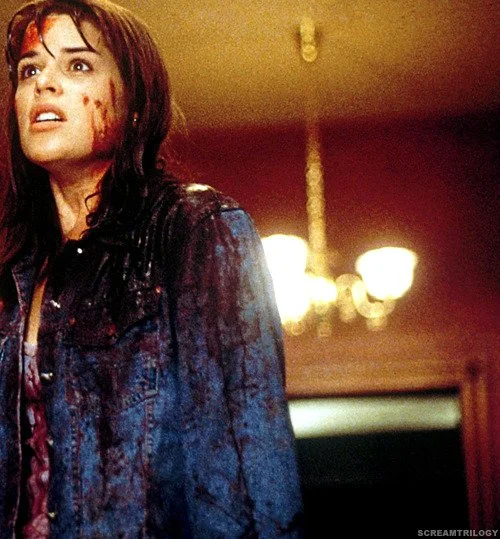Final Girls that Defined Horror
The final girl is the most unkillable woman in cinema.
She’s sweaty, traumatized, running on pure adrenaline and unresolved childhood issues—and yet somehow, she still wins.
What started as a trope for virginal good girls with sensible shoes has mutated into a hall of fame for women who are angry, slightly unhinged, and done being polite about survival. A genre that was created on the backs of women being killed running upstairs in lingerie and high heels has now evolved into an artform that would die without a woman standing triumphantly over a killer’s body just before the credits roll.
With Halloween just around the corner, I’m already planning a rewatch of my favorite slasher films—and these badasses always have a spot in my horror rotation.
Without further delay, here are eight of my all-time favorite final girls—the screamers, the stabbers, and the women who didn’t just make horror their revenge arc.
They made it their bitch.
1. Sidney Prescott (Scream)
Sidney Prescott is the quintessential final girl. She’s been stabbed, slashed, chased, and traumatized in literally every decade since 1996—and she still finds time to deliver therapy-level one-liners.
Sidney Prescott, ‘Scream’
What makes Sidney the gold standard isn’t just her survival rate; it’s her evolution. She goes from terrified teen to trauma-informed terminator. Every Ghostface thinks they can turn her into a victim and minimize her into another plot-device, but every time, she makes them pay for underestimating her.
Sidney doesn’t just survive horror—she outgrows it. She’s the embodiment of endurance, the kind of woman who’s seen the worst humanity has to offer and still chooses peace (after stabbing someone in the gut, obviously). You could put her in a Saw trap and she’d emotionally outgrow and outsmart Jigsaw by act two.
2. Sam & Tara Carpenter (Scream V & VI)
Meet the Gen Z sisters of chaos. Sam has “my dad was a serial killer” issues, and Tara has “I cope through sarcasm and bad decisions” issues. Together, they’re a perfect cocktail of millennial trauma and TikTok-coded rage. Between Sam’s unresolved paternal guilt and Tara's Gen Z nihilistic one-liners, they’ve become one of the most memorable—and lovable—duos in horror.
Tara and Sam Carpenter, ‘Scream VI’
Sam is everything the final girl archetype wasn’t allowed to be—violent, morally gray, and terrifyingly self-aware. She’s proof that surviving isn’t about being good; it’s about being clever. Meanwhile, Tara brings balance, chaos, and that deeply online nihilism that only someone born after 2000 could weaponize mid-attack.
They’re not interested in purity or redemption—they just want to live long enough to unpack their family trauma and maybe post about it later.
And honestly? That’s real growth.
Together, they’re proof that survival can be a family trait—and that sisterhood might just be the deadliest weapon of all.
3. Carly Jones (House of Wax, 2005)
Carly Jones, ‘House of Wax’
Listen: House of Wax may be best remembered for killing off Paris Hilton, but Carly Jones carried that deranged wax-coated fever dream on her back. Elisha Cuthbert gives us a heroine who starts as the skeptical sister and ends up in a glue trap from hell, ripping her own lips apart to escape.
It’s gross, it’s camp, and it’s completely feminist. Carly doesn’t just fight back—she melts the patriarchy, literally. Watching her peel off layers of artifice (and, occasionally, her own skin) feels like a perfect metaphor for mid-2000s horror: messy, meta, and unashamedly over the top.
Carly is that girl who says “I told you so” while covered in blood, holding a flamethrower. She’s underappreciated, underestimated, and impossible to forget. This woman deserves her flowers… and a tetanus shot.
4. Erin Harson (You’re Next)
Erin Harson, ‘You’re Next’
Erin isn’t just surviving—she’s running a masterclass in tactical annihilation. When her boyfriend’s family gathering turns into a home-invasion bloodbath, she doesn’t panic; she plans. She’s setting booby traps, repurposing kitchenware, and dismantling masked killers like she’s auditioning for Home Alone: Rated R.
She’s not the final girl by luck—she’s the final girl because she’s better at killing than everyone else in the room. Erin’s survival isn’t symbolic; it’s skill. She’s the product of a lifetime of self-defense, of never being allowed to feel safe, and she turns that into raw, cinematic retribution. Her character arc is a one-way ticket to a full-circle moment.
Watching her is catharsis. It’s like every woman who’s ever walked to her car with keys between her fingers finally getting her power back—with style, precision, and a hammer.
5. Sienna Shaw (Terrifier 2)
Sienna Shaw, ‘Terrifier 2’
Controversial? Yes. Camp? Also yes. Sienna is what happens when grief, glitter, and Catholic guilt collide. She starts the movie painting angel armor and ends it literally glowing in it, taking on a psychopathic killer clown like she’s avenging every bad Halloween stereotype that came before her.
Sienna is horror’s newest mythology—equal parts saint, scream queen, and fever dream. She’s not just fighting Art the Clown; she’s fighting every manifestation of her guilt, trauma, and survivor’s complex. The fact that she does it while wearing iridescent gold wings and looking like she just raged at a head-banging EDM festival? Iconic.
It’s deranged and oddly spiritual—like Euphoria meets The Exorcist II. She’s proof that modern horror can be outrageous, operatic, and still deeply emotional.
6. Laurie Strode (Halloween franchise)
Laurie Strode, ‘Halloween’
Laurie walked so the rest of them could run (from masked men with knives, of course). She’s the original “trauma core” queen, the woman who’s been hunted for decades and somehow still finds the energy to yell at teenagers about locking their doors.
Jamie Lee Curtis made Laurie not just a survivor, but a philosophy. She turned horror’s helpless babysitter into the ultimate portrait of endurance. Laurie’s not obsessed with Michael Myers—she’s obsessed with control, healing, and occasionally stabbing him in the chest with a knitting needle.
And now, Laurie is the horror version of everyone's favorite fun aunt who drinks wine at noon and refuses to die.
What an icon.
7. Nancy Thompson (A Nightmare on Elm Street)
Nancy Thompson, ‘Nightmare on Elm Street 3: Dream Warriors’
Nancy wasn’t waiting around for a man to save her from Freddy—she was wiring her house like a DIY death trap. She proved that horror didn’t need brawn; it needed brains.
Nancy’s genius is that she’s terrified, but she plans through it. She booby-traps her suburban home with sledgehammers and tripwires, uses caffeine as performance-enhancing drugs, and literally drags a dream demon into reality. She’s the blueprint for every girl who’s ever said, “Fine, I’ll do it myself.”
And unlike most ‘80s final girls, Nancy didn’t just survive one nightmare—she kept coming back for more. She turned her trauma into strategy, her fear into firepower, and her mother’s alcoholism into motivation. If Sidney Prescott is the heart of horror, Nancy is its brain—wired, resourceful, and completely done with men who won’t listen.
8. Grace Le Domas (Ready or Not)
Grace le Domas, ‘Ready or Not’
If you’ve ever fantasized about burning down your in-laws’ mansion, Grace is your patron saint. Drenched in blood, barefoot in a ripped wedding dress, lighting a cigarette while the family literally explodes behind her—Grace is what feminism looks like when you’ve finally had enough.
But what makes her so brilliant is that she doesn’t start as a warrior. She’s just trying to fit in—sweet, awkward, optimistic. Then she realizes her new family’s wedding-night tradition involves ritual sacrifice, and instead of collapsing, she snaps into survival mode with pure, chaotic brilliance.
Grace’s arc is the modern woman’s fairytale gone feral: say “I do,” get hunted, and come out stronger, dirtier, and gloriously unhinged. She’s not surviving love—she’s surviving the patriarchy, the class system, and every gaslighting relative who ever called you “overly emotional.”
Grace doesn’t just end the movie alive—she ends it free.
Final girls endure because they’re done apologizing. Because they’re tired of the helpless persona men expect women to take on in times of distress.
They scream, bleed, and rage their way through the male gaze and come out laughing, knife in hand. Horror may belong to the monsters, but the endings? Those belong to the women who refuse to die quietly.
So when the lights go down and the theme music starts this Halloween, remember: the killers may get the spotlight, but the final girls always get the last laugh.
Because women are notoriously hard to kill. And sometimes, they might just beat you to the punch.








